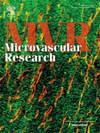Morphometrics of polypoidal choroidal vasculopathy lesions and choroidal vascular associated with treatment response using swept-source optical coherence tomography angiography
IF 2.7
4区 医学
Q2 PERIPHERAL VASCULAR DISEASE
引用次数: 0
Abstract
Purpose
To evaluate quantitative metrics of neovascularization lesions and choroidal vascular using swept-source optical coherence tomography angiography (SS-OCTA) in polypoidal choroidal vasculopathy (PCV) eyes, and investigate the relationship between imaging biomarkers and treatment outcomes of intravitreal anti-vascular endothelial growth factor (VEGF).
Methods
We retrospectively recruited 56 PCV patients. Choroidal features included subfoveal choroidal thickness (SFCT) and choroidal vascularity index (CVI). Quantitative metrics of neovascularization lesions included total vessel length (TVL), average vessel length (AVL), junction density (JD), total number of endpoints (TNE), and mean lacunarity (ML). We performed multivariate logistic and linear regression models to determine the prognostic factors for functional and morphological outcomes.
Results
By comparison, functional good-responders had poorer best corrected visual acuity, higher TNE, and lower ML at baseline. Morphological good-responders had higher central retinal thickness, higher TNE, lower TVL and AVL, lower ML, lower SFCT and CVI. High-shrinkage of vessel area subgroup had higher JD and TNE, lower TVL and AVL, lower ML, lower SFCT and CVI. Multivariate analysis showed good morphological response was correlated with lower SFCT (P < 0.01). High-shrinkage subgroup was correlated with lower AVL (P = 0.017) and higher TNE (P < 0.01).
Conclusion
Quantitative metrics of neovascularization lesions and choroidal characteristics using SS-OCTA had the potential to be imaging biomarkers for predicting the response to anti-VEGF treatment. PCV lesions with higher TNE and lower AVL tended to appear higher shrinkage of vessel area, and lower SFCT was correlated with good morphological response.
使用扫源光学相干断层血管造影术测量多形性脉络膜血管病变的形态计量学以及与治疗反应相关的脉络膜血管。
目的:使用扫源光学相干断层血管成像(SS-OCTA)评估多形性脉络膜血管病(PCV)眼部新生血管病变和脉络膜血管的定量指标,并研究成像生物标志物与玻璃体内抗血管内皮生长因子(VEGF)治疗效果之间的关系:我们回顾性招募了 56 名 PCV 患者。脉络膜特征包括眼底脉络膜厚度(SFCT)和脉络膜血管指数(CVI)。新生血管病变的定量指标包括血管总长度(TVL)、平均血管长度(AVL)、交界密度(JD)、终点总数(TNE)和平均裂隙度(ML)。我们建立了多变量逻辑和线性回归模型,以确定功能和形态学结果的预后因素:结果:相比之下,功能良好反应者基线最佳矫正视力较差,TNE较高,ML较低。形态学良好反应者视网膜中央厚度较高、TNE较高、TVL和AVL较低、ML较低、SFCT和CVI较低。血管面积高度收缩亚组的 JD 和 TNE 较高,TVL 和 AVL 较低,ML 较低,SFCT 和 CVI 较低。多变量分析显示,良好的形态学反应与较低的 SFCT 相关(P 结语):使用 SS-OCTA 对新生血管病变和脉络膜特征进行定量测量,有可能成为预测抗血管内皮生长因子治疗反应的成像生物标志物。TNE较高和AVL较低的PCV病变往往会出现较高的血管面积收缩,而较低的SFCT与良好的形态学反应相关。
本文章由计算机程序翻译,如有差异,请以英文原文为准。
求助全文
约1分钟内获得全文
求助全文
来源期刊

Microvascular research
医学-外周血管病
CiteScore
6.00
自引率
3.20%
发文量
158
审稿时长
43 days
期刊介绍:
Microvascular Research is dedicated to the dissemination of fundamental information related to the microvascular field. Full-length articles presenting the results of original research and brief communications are featured.
Research Areas include:
• Angiogenesis
• Biochemistry
• Bioengineering
• Biomathematics
• Biophysics
• Cancer
• Circulatory homeostasis
• Comparative physiology
• Drug delivery
• Neuropharmacology
• Microvascular pathology
• Rheology
• Tissue Engineering.
 求助内容:
求助内容: 应助结果提醒方式:
应助结果提醒方式:


